Welcome to Part 3/3 in the series of How I Created A Product In China.
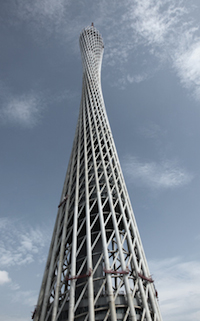 If you missed Part 1 and Part 2 on how to get into manufacturing, make sure you check them out before reading this.
If you missed Part 1 and Part 2 on how to get into manufacturing, make sure you check them out before reading this.
In this post, I’ll outline what’s happened since then and my current updates on building this into something bigger.
As I’ve learned with anything new, you never know with 100% certainty if it’s going to work, so I’m also figuring things out along the way.
This post is broken down into Six Parts:
- Freeing Up More Time
- Supplier Visit In China
- So What’s China Like?
- E-Commerce Platform
- Positioning, Copy, And Photos
- Moving Forward
Freeing Up More Time
In September 2013, I finally left my job in after wailing around for a year and a half.
Since December of 2011, I started ruthlessly cutting my costs while saving money for this eventual exit. There were certain days in the office where I couldn’t wait to get out but looking back, it came a lot sooner than expected.
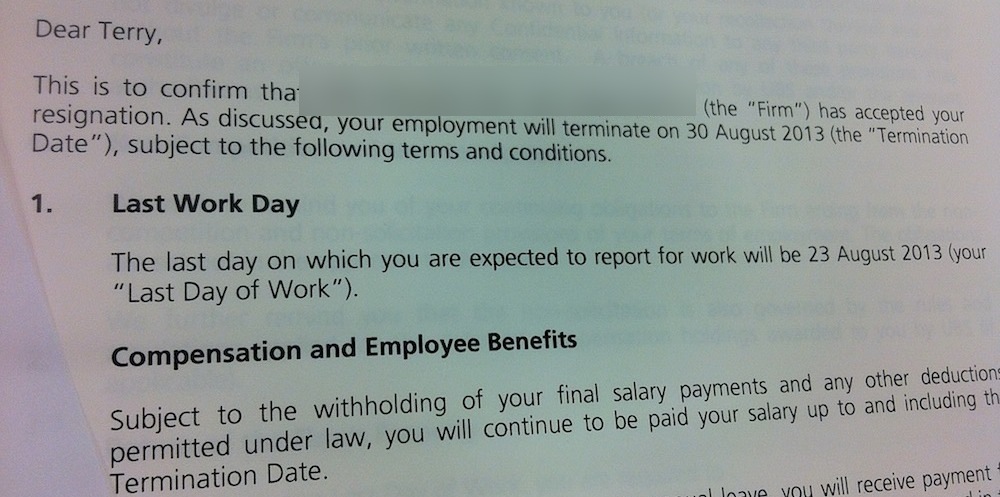
“Last Work Day”
Working part-time has its advantages because it allows you to save money while things are still being figured out. In the book Antifragile, author Nassim Taleb calls this the “barbell strategy” where one plays it safe in some areas while taking risks in others.
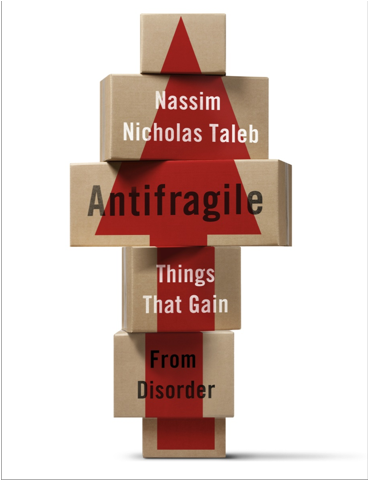 Playing it safe reduces the downside of volatility, while small risks expose you to potentially massive gains.
Playing it safe reduces the downside of volatility, while small risks expose you to potentially massive gains.
If a side business you’re building crashes and fails, you still have a job. But if the side business works out you can live the dream of working for yourself.
Conceptually it makes sense, but we only have 24 hours every day and a limited amount of brainpower that’s able to do mentally intensive work.
My typical workday was about 12 hours on average which is considered easy in Asia. Burning the midnight oil can only last so long because at some point you’ll become the donkey in Buridan’s story.
You may have heard it:
Buridan’s donkey is standing halfway between a pile of hay and a bucket of water. It keeps looking left and right, not sure which one to go for. Unable to come to a conclusion, it eventually falls over and dies of hunger and thirst.
 In my situation, the 12-hour workdays left me mentally drained on weekdays that made it difficult to focus at night.
In my situation, the 12-hour workdays left me mentally drained on weekdays that made it difficult to focus at night.
Time and energy was what I needed at this point so in March 2013, I announced my intention to leave and stayed until August to find a suitable replacement and wrap up major projects.
With a basic proof of concept from pre-sales, a B2B custom project in the works, and a year’s worth of living expenses set aside, I burned the boats and dived in.
How To Get Into Manufacturing: Supplier Visit In China
In the month of July, I used up some remaining vacation days and visited my supplier in China. There were three key reasons I wanted to visit the supplier:
- To learn about the actual production process and see the facilities
- To build a relationship with the supplier
- To take photos for the website “behind the scenes” content
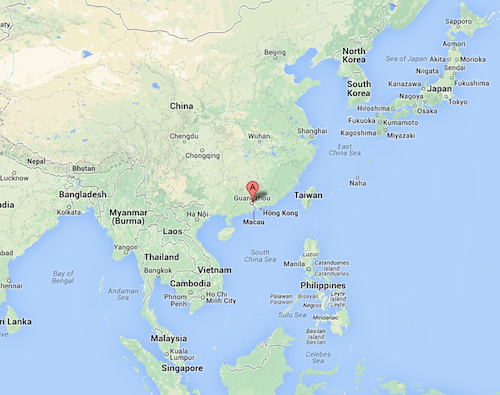
A Trip To Guangzhou, China
One of the biggest mental barriers I had was sending a stranger on the Internet hundreds if not thousands of dollars for a purchase order. I’m just not comfortable moving large sums of money without seeing first-hand what I was getting into.
I’m guessing most people are in the same boat.
So I used up my leftover vacation time, flew to Hong Kong, crossed the border into China, and visited my supplier who was based in the Guangzhou area.

Hong Kong / Shenzhen Border Crossing
Guangzhou is also home to the largest product-sourcing event known as the Canton Fair which happens twice a year in the spring and fall.
The facility was in an office building retro-fitted to be a leatherworking shop. It was surprisingly modern, with a conference room that housed over 150 samples of work they’ve done for other clients.
By seeing these samples in person, it saved me an immense amount of time, energy, and money from going back and forth in emails trying to execute this remotely.
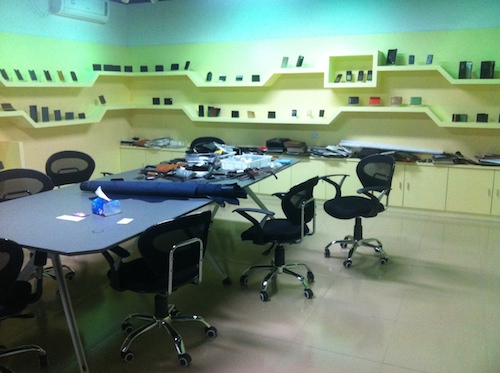
Conference Room
Being there also allowed me to learn about the different types of leather. Why do some leather goods sell for $500, while others are found on Amazon for under $20? What’s the difference between cow, lamb, and ostrich leather? These were just a flurry of questions I asked to get a better understanding on the entire industry.
The actual manufacturing room was quite small, fitting no more than 30 people at once. It was set up more like an art classroom than factory floor, which left me pleasantly surprised. All the production staff had air conditioning as they cut, sewed, and assembled the leather products by hand.
I learned about everything that went into the production process – swivel knives, craft tools, embossing machine, and accessories such as buttons, zippers, and magnets.
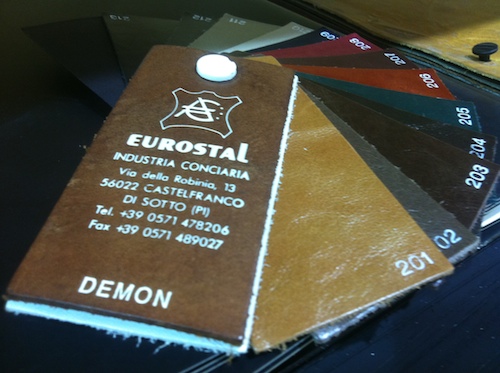
Leather Samples

Mallets And Hammers

Button Portfolio
We spent the entire day talking about leather, samples, and the various customers they’ve done work for from Las Vegas casinos to business tycoons in Dubai.
Over dinner, I learned that they were also a small startup, having quit their jobs from a Japanese luxury brand to try and build a business on their own. The co-founders poached the head designer from another company who’s been in the handmade leather accessories business for 15+ years.
As a result, we had a mutual understanding on the challenges of bootstrapping a business and starting out from scratch.
So What’s China Like?
 Finding a supplier on Alibaba and reading about it on blogs/forums is one thing until you actually land in the country on foot.
Finding a supplier on Alibaba and reading about it on blogs/forums is one thing until you actually land in the country on foot.
China is still experiencing rapid amounts of growth across the country with world class skyscrapers, high-speed bullet trains, and state of the art infrastructure being built across the country.
On the other hand, there are outskirts of major cities that have catching up to do where basic social etiquette is still lacking.
In the manufacturing zones and less developed areas, indoor smoking, spitting, and general unsanitary habits are quite common although they are gradually improving over time.
It can be very unpleasant if it’s your first time visiting, but you’ll just have to mentally prepare yourself and accept that it’s a different culture that’s still in transition.
Before the trip ended, I also got to catch up with some former podcast guests that live in Shenzhen who both have their own podcasts now – Michael Michelini and JP Ji.
Check them out here at China Business Cast and Global From Asia.
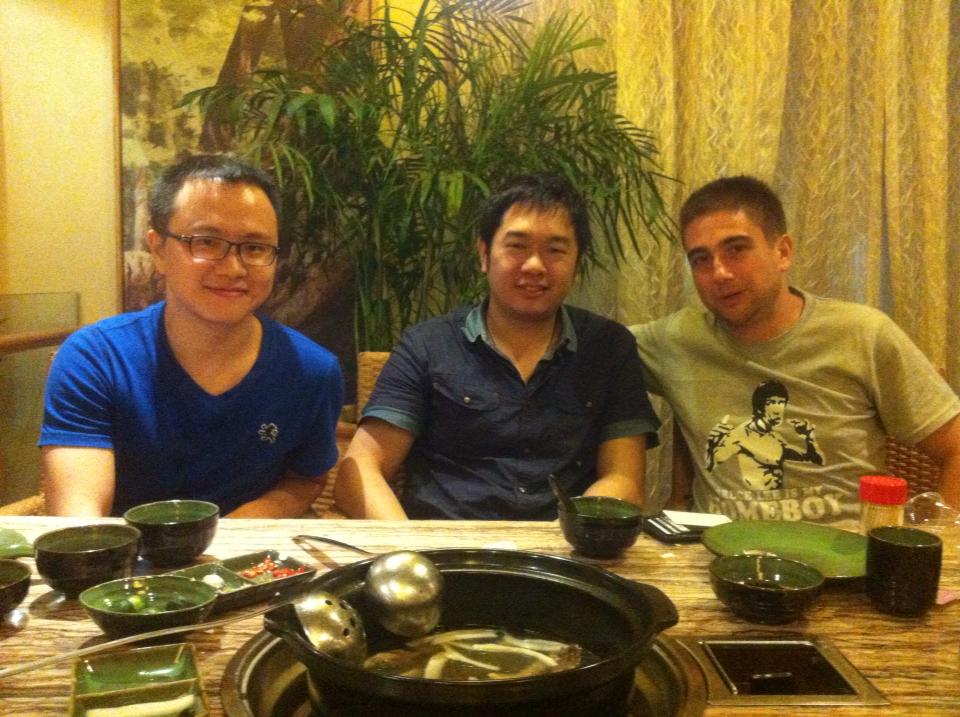
Coconut Chicken Soup with JP and Michael
I was struck with a terrible flu and bronchitis at the end of the trip which put my out for almost a month. Apparently it’s just the rite of passage to get sick with you visit China.
But as the sampling process progressed, the next step was figuring out which e-commerce platform to build the store on.
E-Commerce Platform
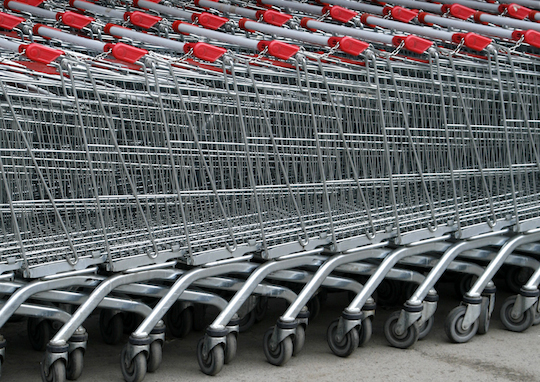 I had long debated between Shopify, BigCommerce, and a relatively new player called Squarespace.
I had long debated between Shopify, BigCommerce, and a relatively new player called Squarespace.
Being a fashion and accessories brand, the design of the website had to look very modern, sharp, and sophisticated.
I briefly went with Squarespace until I realized their backend did not integrate with ANY fulfillment centers. This means that for every order you receive, you’ll have to manually generate a shipping label, update the tracking numbers, and send emails out to customers.
No thanks.
As of December 2013 they’ve integrated with Shipworks, but I’d advise any serious e-commerce merchant to consider other platforms until their backend is more developed.
 So that left me with Shopify or BigCommerce.
So that left me with Shopify or BigCommerce.
Having spoken to dozens of guests on the podcast that use both Shopify and BigCommerce, it was a difficult choice to find the right platform that suited my needs.
Shopify has beautifully designed themes for fashion brands, but their backend isn’t as robust out of the box compared to BigCommerce.
There was also a 2% transaction fee to consider, but since August 2013 it’s been waived if you integrate the store with Shopify Payments.
On the other hand, BigCommerce is still lacking basic blog functionality and many of their themes are just too outdated for a fashion brand. Their support team is also not as robust compared to Shopify, which could become a problem down the line if there were any critical issues.
As I’m quite comfortable with hacking very basic PHP/CSS from WordPress (ie: copy/paste and trial/error), I ended up going with BigCommerce and decided to integrate a blog through the subdomain.
Positioning, Copy And Photos
 Fashion brands are highly dependent upon product photography to convey value and emotion to the customer.
Fashion brands are highly dependent upon product photography to convey value and emotion to the customer.
As a result, I spent an extensive amount of time studying the websites of brands such as Patek Phillipe, Louis Vuitton, Giorgio Armani, and many more to get a sense of how they approached the online world.
Separately, there are online boutique brands such as Vaja Cases and DODOcase that also convey a different sense of brand value. It’s a unique positioning problem because it will determine the style of pictures, design, copy, and descriptions that go into the online store.
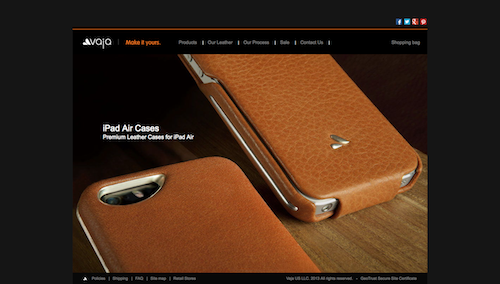
I reached out to a few fashion bloggers to get a sense of the market, and a large majority agreed that there was a growing trend of boutique online brands that people wanted to discover simply because they were different than big-box luxury brands.
The modern consumer (particularly millennials) isn’t satisfied or interested in “me-too” products, and is keenly interested in the stories behind a business and what they stand for.
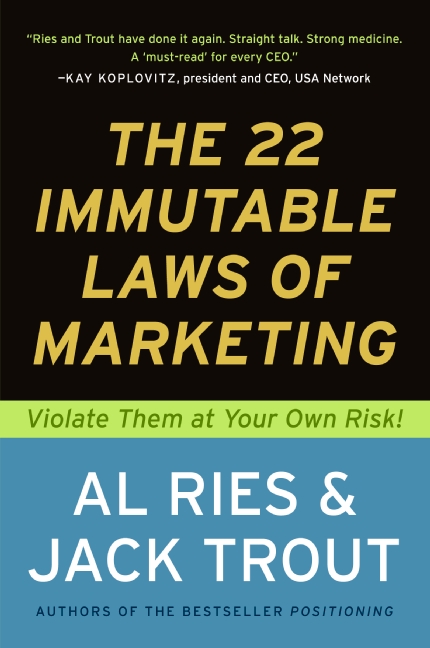 A book I’ve been reviewing lately to help figure this out is called the 22 Laws of Marketing.
A book I’ve been reviewing lately to help figure this out is called the 22 Laws of Marketing.
Written nearly 20 years ago to a “big advertising” audience, the concepts are still strikingly relevant as I heard Tim Ferriss mentioned on a podcast last year.
If you’ve never read the book I’d highly recommend it. The first five laws are probably the most critical for a brand to figure out:
- Leadership: People know #1, but can’t name #2
- Category: If you cannot be #1, set up a new one.
- Mind: It’s better to be first of mind than first in marketplace.
- Perception: Marketing is not a battle of products, but rather perceptions.
- Focus: Own a word in the prospect’s mind.
 Branding is one of those tricking things that are intangible yet hiding in plain sight.
Branding is one of those tricking things that are intangible yet hiding in plain sight.
When you hear the names of Google, Nike, and McDonalds there are certain emotions and images you associate with them based on the brand equity they’ve built.
It’s a delicate blend of ideas, names, emotions, philosophies, values, and the overall customer experience.
In a few weeks, I’ve got Pamela Wilson from Big Brand System on the podcast soon that will help shed some light on creating a brand with advice that’s more concrete and actionable.
One article I’ve found also helpful was Clayton Christensen’s Milkshake Marketing published in 2011. In the article, they studied the consumer behavior of a fast food chain that wanted to boost its milkshake sales.
 As consumers came in and left, they surveyed them on what they hired the milkshake to do, where they were going, and if they considered other alternatives before buying it.
As consumers came in and left, they surveyed them on what they hired the milkshake to do, where they were going, and if they considered other alternatives before buying it.
It turns out the typical consumer bought a milkshake for their morning commute, wanting something to keep them entertained in the car while keeping them full until lunch.
It’s difficult to eat a banana while driving, having a bagel would create a mess, and gorging on a Snickers bar would make you feel guilty.
The milkshake did the job well by fitting perfectly into the cup holder, and thus his concept of milkshake marketing was born.
“The jobs-to-be-done point of view causes you to crawl into the skin of your customer and go with her as she goes about her day, always asking the question as she does something: Why did she do it that way?”
Christensen argues that consumers don’t buy because they’re in the demographic group of men, aged 25-34, with a college degree, and drive the same model of Lexus. It’s correlated with the decision, but isn’t the root cause.
 So what’s the job to be done with a wallet?
So what’s the job to be done with a wallet?
It took me a while to realize this but when you think about a man’s wallet, it’s the one item he uses every day.
It accompanies him day and night, through thick and thin, while remaining steadfast by his side for months and years.
Money, credit cards, and identification are carried in this symbolic vessel that represents his life.
 As a result, this makes purchasing a wallet something very personal for each individual.
As a result, this makes purchasing a wallet something very personal for each individual.
With this unique relationship a guy has with his wallet, designing and crafting it must be taken very seriously.
On a deeper level, the resulting choice is a reflection on how he sees himself and the image he chooses to project to the rest of the world.
Does he enjoy the simple things in life going for a minimalist route? Or perhaps social status is important for him, so he purchases Louis Vuitton wallets that cost $300 or more?
The brand message will have to resonate with their identity to stand out (Law #1) from the thousands of other alternatives on the market.
So how does one start this from scratch?
Good question, because I’m still trying to figure this out too.
Moving Forward
One of the biggest grievances I have with product manufacturing is how long things can take. Designing, tweaking, producing, and mailing a sample can take anywhere from 2-3 weeks.
The process is inevitably dragged on with peripheral tasks like designing the product box, taking photos, printing thank you cards, and figuring out logistics for fulfillment.

I’m about to wrap up the sampling process by the end of December launching with 4-5 SKUs. The remaining weeks of 2013 will involve product photography, continual outreach to men’s fashion blogs, and putting them on the website to collect more pre-orders before putting in the final deposit down for my first production run.
Stay tuned for the details and results in future posts, and I’ll see you guys next time.
Subscribe to Build My Online Store in your favorite podcast player, or check out the episode list of our eCommerce podcast.

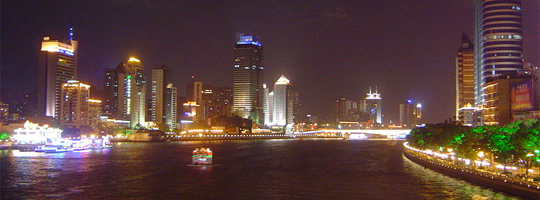 Welcome to Part 3/3 in the series of How I Created A Product In China.
Welcome to Part 3/3 in the series of How I Created A Product In China.
Comments
Great post, The first time I sourced something in China was out of shear desperation. As a side business I was personally making small fly fishing boxes, after making close to 1000 of them and missing out on my life/wife and kids, I took the leap and sent some samples to 3 manufactures in China. A couple weeks later and $300 dollars in Fedex charges I had samples back. 7 years ago my initial order was for 50 boxes sent Fedex, last week a semi pulled into my neighborhood and dropped of 8,000 sent by ship. Lots of strange looks from the neighbors!! I’ve struggled with quality concerns, customs, and delivery. The best advise I could give is to be patient but work steadily toward your goal. Plus work with your suppliers, your success is there success.
“On the other hand, there are outskirts of major cities that have catching up to do where basic social etiquette is still lacking.
In the manufacturing zones and less developed areas, indoor smoking, spitting, and general unsanitary habits are quite common although they are gradually improving over time.”
As an American living overseas, I’m continually amused by Westerners deeming “their” societal norms as basic social etiquette and anything less is “lacking”.
“Human” social etiquette would be respecting the societal norms you encounter when “visiting” a foreign country, not deeming them lacking, or that they’re improving or catching up to western standards.
Unless you want to deem yourself as yet another arrogant Westerner, I suggest you consider that there may be business practices that differ as well, and be open to the idea that the world isn’t black & white, just different. 🙂
Yep I agree – it’s different but there are some things I just don’t enjoy in China as there are in the US, or anywhere else.
Most people would be shocked to see kids peeing in elevators or similar things in the outskirts of cities, so it was written as a kind warning for anyone that steps foot there for the first time.
Kid peeing in an elevator. That’s a new one. 🙂 Saw a kid pissing in a bottle in the aisle of a bus. He made a bit of a mess anyway, but the bus attendant admonished the mother, made her clean up, and pointed out the bus had a toilet on board. 🙂 Not a societal norm, just an ignorant woman.
On a completely different topic, what’s the story with your avatar photo? 🙂
Yeah it was in outer Beijing where my parents live – guess you learn something new everyday. But I’d say in a few years this stuff will be gone, Taiwan was like that 15-20 years ago and it’s very civil here now.
I was a former 007 that defected to e-commerce.
Really looking forward to your updates on this. I live in Bangkok and have contemplated doing something with raw denim and leather, as it’s really popular here.
Are you still in Taipei? I hear great things about the girls and nightlife there. It’s high on my list to visit.